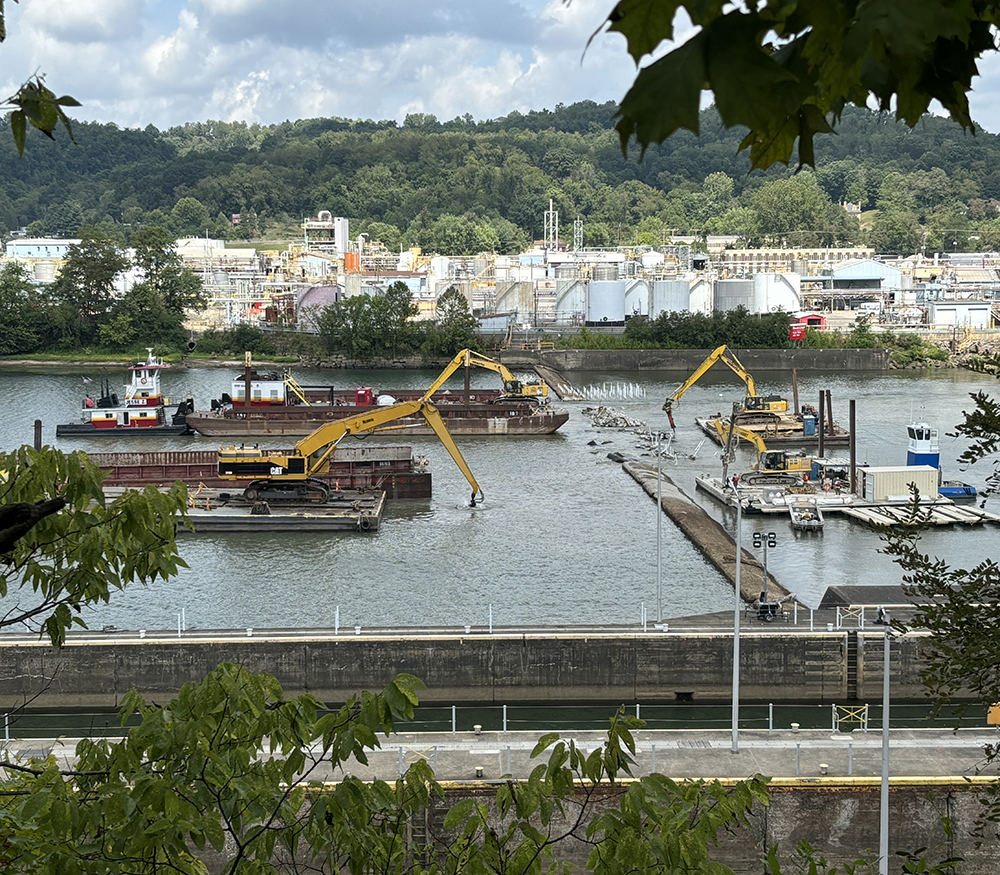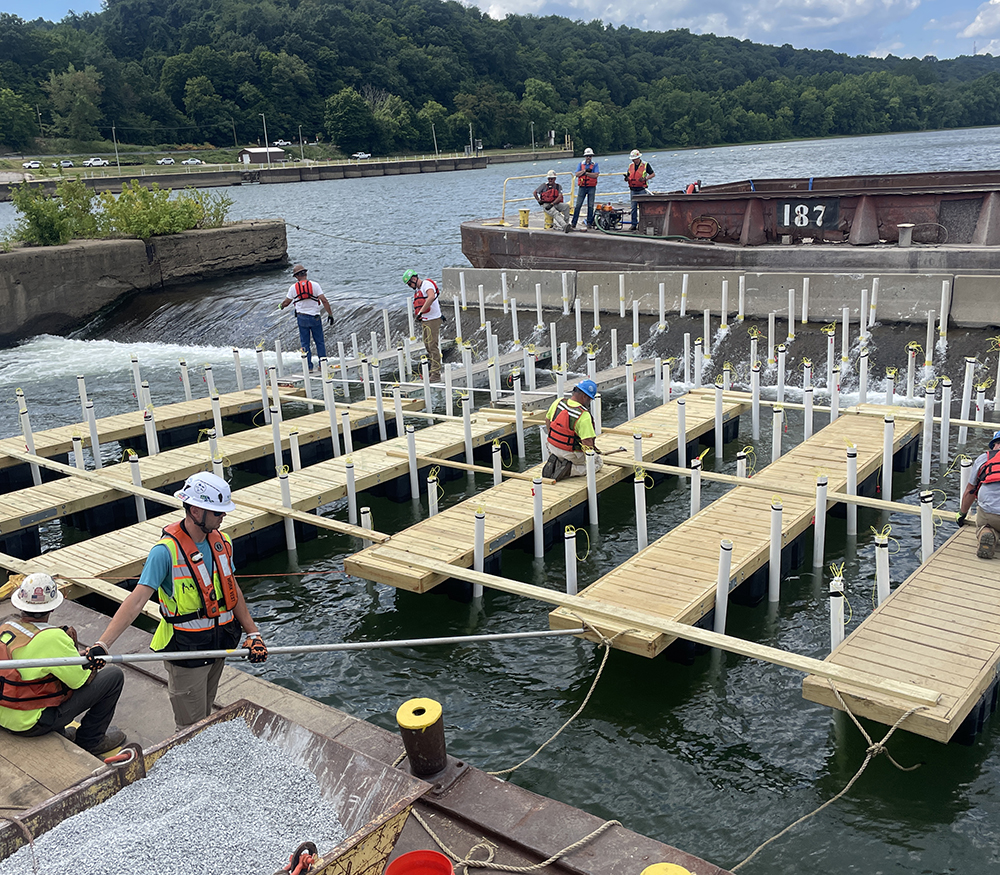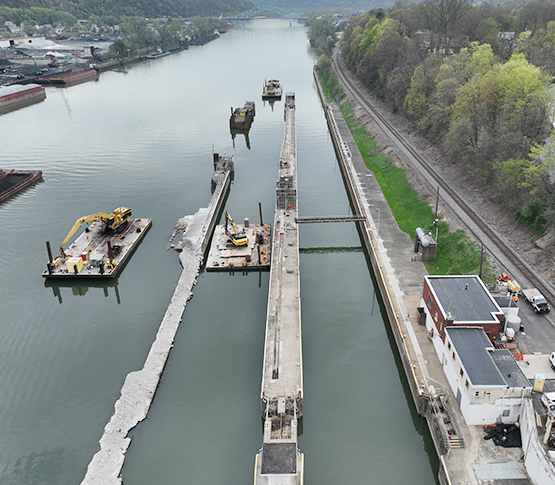Monongahela River Locks and Dam no. 3 Demolition
Elizabeth, PA
| Location: | Elizabeth, PA |
| Owner: | US Army Corps of Engineers |
| Construction Company: | Fay, S&B USA Construction |
| Project Status: | Construction began in April 2024 and is scheduled for completion by March 2027 |
This project is demolishing and decommissioning the Monongahela River Locks and Dam no. 3 in southwestern Pennsylvania to establish a new navigable channel and stabilize the monoliths that will remain after construction.
Expanding Unrestricted River Navigation for Business and Recreation
Project Highlights
- Demolish 683-ft-long fixed crest concrete dam
- Open a new navigable channel by surveying upstream and downstream of the removed dam, and removing high spots by dredging
- Demolish the existing river wall and middle wall of the lock chambers
- Install recycled concrete rubble as a stability berm against the existing land wall
- Construct concrete cap on land wall esplanade
Fay, S&B USA Construction (Fay) was contracted by the U.S. Army Corps of Engineers (USACE) to demolish the aging Monongahela River Locks and Dam No. 3, which has been in place since 1907. Removing the dam would create a new navigable channel for barges and boats on this part of the Monongahela River, followed by stabilizing the dam monoliths that will remain after construction.
According to USACE, removing the dam would eliminate an aging bottleneck that required costly maintenance and caused commercial boats with large tows to slow down through this portion of the river, and open 33 navigable miles of waterways to industry and recreational boaters. This project is part of the Lower Monongahela River Project, which provides $200 million in economic benefits to navigation industries annually.
In a series of controlled implosions, Fay breached the existing dam to equalize river levels on both sides of the former dam. The project team will continue to demolish several more structures, including the middle wall, river wall, upper guard wall cells, and the river chamber extension cells, then place stability berms against the land wall and left dam abutment. Afterwards, Fay will install permanent stabilization measures for the flume way, land wall, upper guide walls, and dam abutment.
Challenges
Fay needed to perform all demolition work, including the blasting, safely and in close coordination with USACE, U.S. Coast Guard, CSX, and local agencies to ensure public and worker safety, and to limit the amount of time the river would be closed. Fay also had to comply with environmental protections for the river’s aquatic life, and process and reuse as much demolition material as possible.Solutions
With extensive experience in marine work and demolition, Fay worked with USACE on a plan to breach the approximately 683-ft dam using a series of nine controlled implosions and traditional demolition. The project team waited until July when time-of-year restrictions were over to perform any blasting. Fay conducted the implosions once per week, publicly announcing each blast in advance, and worked with USACE, U.S. Coast Guard and other agencies to close the river to navigation during these events. Following the first implosion, Fay paused demolition for several days while the water equalized, allowing river mussels to relocate according to the new water level. Fay continued using its marine fleet and heavy equipment to complete the demolition of the dam and lock structures.Construction
Fay began work in April 2024 and performed the first demolition blast in July. The dam was fully removed and the new navigation channel opened by the end of 2024. Following the implosion of the concrete, Fay teams used a barge-mounted excavator with clam buckets to gather the rubble and transport it to shore by barge. They also used a barge-mounted excavator equipped with a hydraulic impact breaker to break larger rubble into smaller pieces for removal. This process was repeated until the entire length of the dam was demolished.Following demolition of the dam, Fay will construct the new navigable channel on the Monongahela River by surveying upstream and downstream of the removed dam to locate and dredge any material above the required navigation elevation.
After the new navigable channel opens, the land and river chambers will permanently close for the demolition of the river wall and middle wall. Project work will conclude with the placement of stability berms on the right descending bank against the land wall, filling the flume way, and placing a new concrete cap on the esplanade. Processed concrete material from the demolition will be brought back from the laydown yard to the river for use in the stability berms.
All contract work is scheduled for completion by March 2027.




